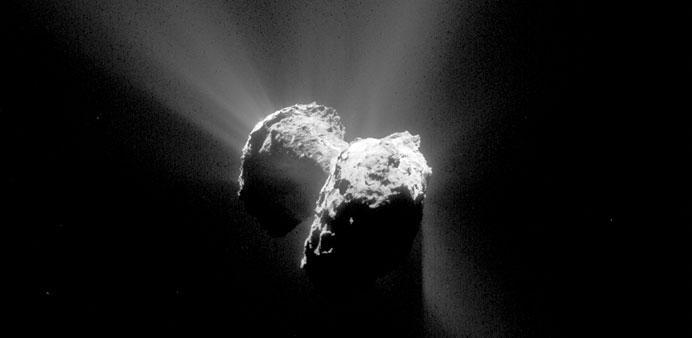NEW EVIDENCE: The two lobes of comet 67P/Churyumov-Gerasimenko were once distinct objects, according to a new study.
By Deborah Netburn
How did Rosetta’s rubber-duck-shaped comet get its funky, two-lobed look?
In a paper published in Nature, researchers say that the nucleus of comet 67P/Churyumov-Gerasimenko is made of two formerly distinct bodies that likely came together in a gentle collision in the early stages of the solar system.
It’s a cometary partnership that has lasted billions of years.
The European Space Agency’s Rosetta orbiter began sending back the earliest images of comet 67P’s strange, bi-lobed shape in July 2014, and scientists have been wondering about the origins of its unusual morphology ever since.
The comet has three distinct regions — a major lobe (the main body of the “duck”), a minor lobe (the head) and a thin, neck-like region that connects the two.
“Since we resolved the comet, the question of whether it was two objects that joined together or one comet that has been eaten away has been dangling,” said Matt Taylor of the European Space Agency, project scientist for the Rosetta mission. “Now we have answered it — it’s a contact binary.”
To come to this conclusion, an international research team analysed images of the comet collected by cameras aboard the Rosetta orbiter.
The scientists were particularly interested in the distinct layers of material called strata that were visible along the comet’s many steep cliffs, and which continue at least 2,000 feet into the centre of its nucleus. These co-centric strata suggest that the structure of the comet is similar to that of an onion.
If the comet had always been just one body with what looks like a bite taken out of it, the scientists would expect to see the layers on both lobes arranged around a centre point of gravity close to the neck. Instead, the researchers observed that the layers were generally well-ordered around the local gravity of each lobe. This suggests the lobes formed individually, each around their own centre of mass.
The scientists were also able to show that the strata across the neck region do not match up with the strata on either the body or the head of the comet. In addition, the team looked at gravity vectors that run perpendicular to the strata and found that they matched computer models of two separate objects, rather than a single object.
“All together, these three lines of evidence leave a very narrow space for doubt,” said Matteo Massironi of the University of Padua in Italy, who led the investigation.
Joseph Masiero, a Jet Propulsion Laboratory scientist who specialises in asteroids and comets and who was not involved in the study, said the argument is convincing.
“If you put it together, it looks like you have two onions sitting next to each other, not a single onion with a piece taken out,” he said.
The authors note that the two lobes of comet 67P are strikingly similar in terms of their structure, which suggests that both lobes may have come from the same region of the solar system, or at least formed through similar processes, Taylor said.
However, questions remain. The paper does not address what processes helped these two bodies become one. Most impacts cause objects to break apart, not stick together. Could these two objects simply have nudged each other and then stuck together?
Possibly. In a paper published earlier this year in Science, a different set of researchers used 3-D computer simulations to show how two bodies moving at bicycle speed might gently collide and then merge together. They also found that very low-velocity impact would displace some but not all of the material on the two bodies involved.
Massironi said the two objects that make up comet 67P are not necessarily being held together just by gravity.
“I think gravity might not be the only holding agent,” he said. “There could have been some processes of cementation during the collision itself and in the following evolution of the comet.”
It seems more work will need to be done on that line of inquiry as well.
“They convinced me that these are two things stuck together,” Masiero said. “But how do you stick them together? That’s clearly the next question.” — Los Angeles Times/TNS

